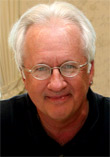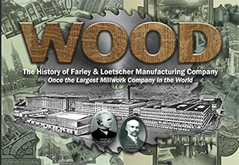The Murals of

Senior High School's lovingly restored Lamb-Hedeman Auditorium is the finest example of Arts & Crafts Movement interior design, but it also contains Depression Era murals by local painter, Cy Ferring that represent an incredible art treasure the value of which is beyond measure.
Photos and Story by Gary Olsen with contributed historical data
 n the large mural depicted above is a splendid example of regional painting style made famous by Thomas Hart Benton and celebrated Iowa artist from this same era (the 1930's) Grant Wood. The slightly elongated and heroic figures, the characters depicted from African American boat n the large mural depicted above is a splendid example of regional painting style made famous by Thomas Hart Benton and celebrated Iowa artist from this same era (the 1930's) Grant Wood. The slightly elongated and heroic figures, the characters depicted from African American boat  hands unloading supplies on the riverbank to an obviously wealthy family perhaps supervising their burgeoning capital investment in the form of a steam powered sawmill in the third panel. All levels of society are depicted including a Civil War soldier. But who is the artist that painted these beautiful murals? It was Cyril P. Ferring, a Dubuque native. hands unloading supplies on the riverbank to an obviously wealthy family perhaps supervising their burgeoning capital investment in the form of a steam powered sawmill in the third panel. All levels of society are depicted including a Civil War soldier. But who is the artist that painted these beautiful murals? It was Cyril P. Ferring, a Dubuque native.

When I first saw the murals at Senior High as a college student back in the 1960's, I knew I had discovered a treasure. It was so inspiring, I promised that I would learn more about the artist. My growing enthusiasm for interior design and architecture made me love the murals and the magnificent auditorium in which they reside even more. Later, when I became an employee of the district, I vowed that I would do everything I could to preserve and save these murals. Fortunately, there were several in our community who agreed with me, and they shouldered the responsibility to preserve and save them for all time.
These are the people and organizations who have helped preserve the auditorium and murals and to whom we owe a great debt of thanks:
- The Dubuque Senior Educational Foundation
- The Dubuque Community School District
- The Dubuque Community Building and Grounds Crew
- The Dubuque Racing Association
- The Falb Family
- The Henry Family
- The Mozena Family
Cyril P. Ferring was an artist and graphic designer, and he ultimately wound up in Chicago where he met with much international success. He illustrated very popular children's books such as How Life Begins (Chicago Book House for Children 1935). I've been trying to find a copy of it, and I think I found one on e-Bay.
Cyril P. Ferring attended school in Dubuque and graduated from Dubuque High School in June, 1919 (predecessor to Dubuque Senior High School).
In May of 1934, he was sent to England to make sketches of King George's Jubilee that would be used later for advertising. Royal events like anniversaries were often celebrated with advertising specialties like tea sets, silk banners, and badges upon which the likenesses of the Royal Family were depicted.
Cy Ferring's work is best known among Dubuque residents as a series of prints of Dubuque scenes that were published and can still be found in many homes throughout Dubuque. At one time the Dubuque Golf & Country Club had images drawn by Cy Ferring laminated in its bar (long gone sorry to say). His illustrations of Dubuque landmarks and some original paintings are still in the hands of Dubuque families and some are in the collections of the City of Dubuque and the Dubuque Museum of Art.
Not too long ago, I was at an estate auction where I discovered a complete set of Cy Ferring prints laminated in of all things placemats.
But let's talk about these magnificent murals that grace the walls of Senior High School's Lamb Hedeman Auditorium which was recently restored to its finest Arts & Crafts architectural-style details thanks in large part to private donations.
First of all, as a painter myself, I marvel at the detail and movement of the composition. His use of background colors and hazy detail in that background make the foreground images pop. Ferring's technique produces incredible depth.
Since the murals were restored by Gary Germaine of Dubuque not too long ago, the colors shimmer in beautiful harmony. Ferring's palette was decidedly warm.
I particularly love how he depicts his figures. The Indian standing with his hand on the tree is positively heroic in stature. If you look at the detail of the first and largest mural, you may see what appears to me a young Abraham Lincoln lounging on the deck of the riverboat on the left.
Figures in the mural are slightly elongated, statuesque, and they evoke the style of figure painters of the early to mid 20th Century like Thomas Hart Benton and Grant Wood, two of my favorite artists of the 20th Century. Cy Ferring taught art and figure study at the Chicago Academy of Fine Arts.
The sky and trees are evocative of another great illustrator of the period, N.C. Wyeth, an artist and illustrator like Ferring whose work was made popular in the Scribner Classics, Ivanhoe, Robin Hood, Treasure Island and many more.
There are all kinds of figures and details in the murals you can't see from the floor of the theater. In the Agriculture Mural, behind the farmer as he plows the field, two children are seen running toward him with what appears to be lunch! There are other interesting details that you may find upon your close inspection of the photographs I've taken and are acceessible by clicking on them which will download the high resolution images into your browser.
The bluff line in the background looks almost identical to the two previously depicted bluffs in the mural but with fewer trees. As steamboats plied the Mississippi River, vast forests of trees on both sides of the river all the way to Minneapolis were harvested for fuel and lumber. Trees had to be cleared for farms and the wood used for building cabins initially, but later the logs floated down river to sawmills like the one depicted in the third panel. The lumber and millwork industry thrived in Dubuque for nearly 100 years of the city's early history. I just completed the design for a book on this industry that we are publishing for author, Carole Loetscher working with my design partner, David Palmer. The book is called Wood,,, The History of Farley & Loetscher Manufacturing Company - Once the Largest Millwork Company in the World (click on the cover below to see an enlargement of the cover).

There was some controversy among students at Senior in the '70s and '80s that the depiction of the African American dock hands in the mural was racist. I would counter that Ferring was merely depicting life on the Mississippi as it was in the 1800s. Most of the roustabouts, deckhands and dock workers at the time were African Americans, and they were not necessarily indentured but paid well for their labor. River transportation gave opportunity to countless African Americans in their northward migration during the 1800s. There were several safe houses in river towns all along the Mississippi from Hannibal, MO to Dubuque, IA that offered protection to runaway slaves.
It's a good thing Senior High School is heated by steam and radiators. This actually served to preserve the murals against soot. There is not a lot of natural light in the auditorium, so sunlight couldn't bleach the colors nor cause any deterioration. The murals are almost perfect today as when they were painted, though there has been some restorative work, of course.
About the Auditorium
The murals are a wonderful complement to the Arts & Crafts Style interior design made popular during the first half of the 20th Century. Examples of it can be found throughout Europe and North America.
In the United States, the terms Arts & Crafts denotes the style of architecture, interior design, and decorative arts that prevailed between the dominant eras of Art Nouveau and Art Deco, or roughly the period from 1910 to 1925. *
Perhaps the greatest practiotioner of the Arts & Crafts Movement was Frank Lloyd Wright. All aspects of his designs were infused with the hallmarks of the movement, quarter sawn oak furniture and woodwork, leaded windows purposely tarnished patina copper fixtures.
Inspired by the writings of John Ruskin and a romantic idealization of the craftsman taking pride in his personal handiwork, it was at its height between approximately 1880 and 1910. However the design inspiration of the movement persisted well into the 20th Century with the architectural designs of Wright, Gustav Stickley (famous for his furniture designs), Lester S. Moore, Charles Robert Ashbee, and several others.*
There are several examples of this design movement in Dubuque, Iowa, most notably the pavilions of Eagle Point Park and, of course, several houses built in the early half of the 20th Century. There are some structures being built today that evoke the now classic style. Buildings belonging to Premier Bank in Dubuque located on Kennedy Road and at Asbury Plaza.
*Source information from Wikipedia the Online Encyclopedia
Gary Olsen is a Dubuque artist and retired Media Developer for the Dubuque Community Schools. He can be reached by e-mail. If you can provide any interesting annecdotal or published details on Cyril P. Ferring and his life in Dubuque and Chicago, we would appreciate hearing from you |

